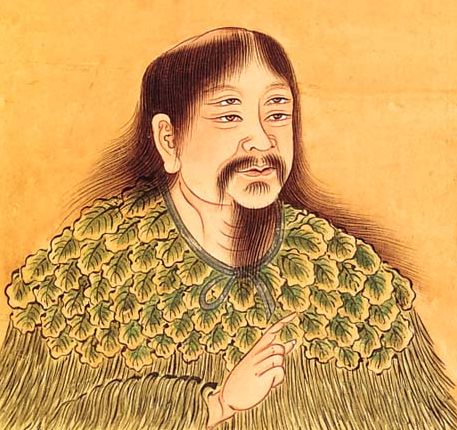Words and Legends / 字的故事
I'm going to tell a legend to Karolina for return of her two stories. Base on her interests of postcard theme, I choose calligraphy art of traditional Chinese culture. This postcard is from National Taiwan University Faculties, Staff and Students Union Exhibition of Traditional Chinese Art. This year is the fourth time of the exhibition.
Traditional Chinese characters are truly treasures of east Asia. There are many races using them to write their spoken languages. Some races even have derivation characters for their own languages.
Legend of character creation is like this:
Cangjie, (pronounced like Ts'ang-chieh) was the saint who created Chinese characters. In the legends, he had four eyes and there are two pupils in each. This is usually one special feature of saints. He was the history keep officer of the Yellow Emperor. After unifying China, the Emperor needed to remember more things. So he was not satisfied with 'rope knot tying' method, and asked Cangjie to solve this problem.
One day, Cangjie thought of this issue along the riverside. A phoenix flew by and dropped a stick with one animal footprint. While He was wonder what animal made the print, a hunter walked by and told him, 'I can recognise all animals by their footprints'. The idea came into Cangjie's mind. Yes, he could use lines to record everything's feature stroke by stroke.
According to a history book, after he created characters, it rained millet from the heaven and ghosts cried at late night. It is because the nature could not hide its secret and the ghosts could not transform freely. People can write to record and describe.
The Chinese characters transformed several times. The fonts we use nowadays are similar with the ones our ancestors used 2,000 years ago. However, mainland China simplified characters in 1950's and now uses different fonts from Taiwan. We Chinese Taiwanese now still use traditional Chinese while Chinese in China use non-traditional.
The couplet is read like this:
為了回報卡羅琳娜的兩個故事。我依據他交換明信片網站中的檔案,挑了中華傳統文化中的書法片給他,預計向他訴說「倉頡造字」的故事,以及中文各式字體與簡化的分合。這張片子是國立臺灣大學第四屆師生金石書畫聯展的作品,本年度展覽名稱為「墨筆輕描山水綠、銀鉤遠掛夕陽紅」。
漢字在東亞文化圈中,實實在在是個文化瑰寶,除了漢族使用外,還有許多不同的民族使用,也有民族自行衍生出類似的體系。然而文字的生成在中國是有故事的:
傳說漢字是由一位名叫作「倉頡」聖人發明的。根據記載,倉頡有四隻眼睛,每個眼睛裡有兩顆瞳孔,通常都是聖人才有此異像。他是上古時代黃帝的史官,黃帝在統一中國後,感到結繩記事的不足而命他想辦法解決。有一天倉頡在河邊苦思解決之道,遠處飛來一隻鳳凰,從牠嘴中落下一件物品,是個帶有獸爪印的東西。他正好奇這是什麼動物留下的,剛好有位路過得獵人就告訴他,他可以依據這個足跡來判斷各種動物的種類。這件事啟發了倉頡,他想到可用線條來表現萬物的樣貌,如此即可記事。
當倉頡造好字時,《淮南子·本經》中記載:「天雨粟,鬼夜哭。」原因在於造化不能藏其秘,故天雨粟;靈怪不能遁其形,故鬼夜哭。
本片同時於官方交換活動中寄出。This postcard was also sent for postcrossing official card.
Traditional Chinese characters are truly treasures of east Asia. There are many races using them to write their spoken languages. Some races even have derivation characters for their own languages.
Legend of character creation is like this:
Cangjie, (pronounced like Ts'ang-chieh) was the saint who created Chinese characters. In the legends, he had four eyes and there are two pupils in each. This is usually one special feature of saints. He was the history keep officer of the Yellow Emperor. After unifying China, the Emperor needed to remember more things. So he was not satisfied with 'rope knot tying' method, and asked Cangjie to solve this problem.
One day, Cangjie thought of this issue along the riverside. A phoenix flew by and dropped a stick with one animal footprint. While He was wonder what animal made the print, a hunter walked by and told him, 'I can recognise all animals by their footprints'. The idea came into Cangjie's mind. Yes, he could use lines to record everything's feature stroke by stroke.
According to a history book, after he created characters, it rained millet from the heaven and ghosts cried at late night. It is because the nature could not hide its secret and the ghosts could not transform freely. People can write to record and describe.
The Chinese characters transformed several times. The fonts we use nowadays are similar with the ones our ancestors used 2,000 years ago. However, mainland China simplified characters in 1950's and now uses different fonts from Taiwan. We Chinese Taiwanese now still use traditional Chinese while Chinese in China use non-traditional.
The couplet is read like this:
The scenery of the country is good everywhere.
The rain and dew wash everything to a new look.
為了回報卡羅琳娜的兩個故事。我依據他交換明信片網站中的檔案,挑了中華傳統文化中的書法片給他,預計向他訴說「倉頡造字」的故事,以及中文各式字體與簡化的分合。這張片子是國立臺灣大學第四屆師生金石書畫聯展的作品,本年度展覽名稱為「墨筆輕描山水綠、銀鉤遠掛夕陽紅」。
漢字在東亞文化圈中,實實在在是個文化瑰寶,除了漢族使用外,還有許多不同的民族使用,也有民族自行衍生出類似的體系。然而文字的生成在中國是有故事的:
傳說漢字是由一位名叫作「倉頡」聖人發明的。根據記載,倉頡有四隻眼睛,每個眼睛裡有兩顆瞳孔,通常都是聖人才有此異像。他是上古時代黃帝的史官,黃帝在統一中國後,感到結繩記事的不足而命他想辦法解決。有一天倉頡在河邊苦思解決之道,遠處飛來一隻鳳凰,從牠嘴中落下一件物品,是個帶有獸爪印的東西。他正好奇這是什麼動物留下的,剛好有位路過得獵人就告訴他,他可以依據這個足跡來判斷各種動物的種類。這件事啟發了倉頡,他想到可用線條來表現萬物的樣貌,如此即可記事。
當倉頡造好字時,《淮南子·本經》中記載:「天雨粟,鬼夜哭。」原因在於造化不能藏其秘,故天雨粟;靈怪不能遁其形,故鬼夜哭。
本片同時於官方交換活動中寄出。This postcard was also sent for postcrossing official card.
From: Taipei, Taiwan Date: 26 May to 4 June , 2010 Sender: Dodd To: Beatriz in Viseu, Portugal | 寄自:臺灣臺北 日期:2010年5月26日至6月4日 寄者:Dodd 收件人:葡萄牙維蘇的碧翠絲 |







0 comments:
Post a Comment